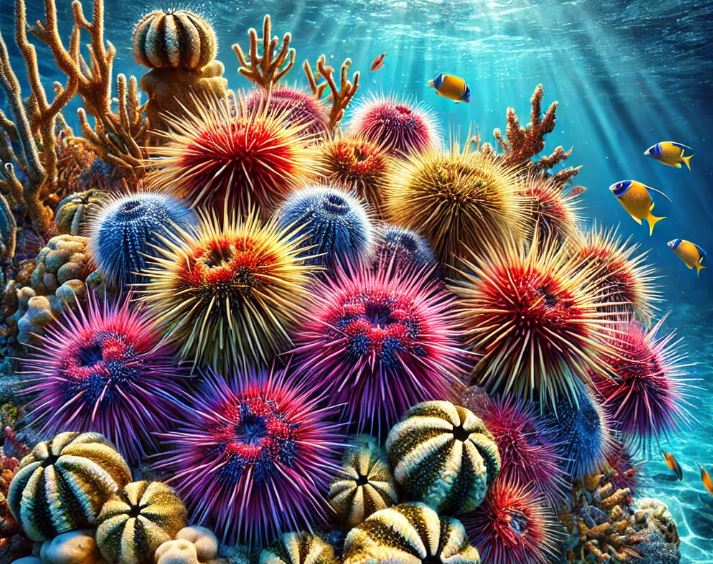Underwater World: A Glimpse of Vibrant Sea Urchins and Coral Reefs – By Bhanuka – eLanka

Sea urchins are fascinating marine creatures that inhabit oceans around the world, playing a vital role in the marine ecosystem. These spiny echinoderms belong to the class Echinoidea and are closely related to sand dollars, sea cucumbers, and starfish. Found predominantly on rocky seabeds, coral reefs, and kelp forests, sea urchins contribute significantly to the balance and health of their environment, while also serving as a source of intrigue and value to humans.
Sea urchins possess a round, symmetrical body covered in long, movable spines. These spines not only provide protection from predators but also aid in locomotion. Beneath the spines lies a hard, shell-like exoskeleton known as a “test,” which is made up of calcium carbonate plates. The test is perforated with small holes through which the sea urchin’s tube feet extend. These tube feet are part of their water vascular system, allowing them to move, attach to surfaces, and capture food with remarkable precision.
One of the most intriguing aspects of sea urchins is their feeding mechanism. They possess a unique structure known as “Aristotle’s lantern,” a complex arrangement of five calcareous plates that function like teeth. This apparatus allows sea urchins to scrape algae off rocks, devour kelp, and even bore into hard surfaces such as coral and stone. Their diet varies depending on the species and habitat but primarily consists of algae, seaweed, and decaying organic matter. By feeding on algae and kelp, sea urchins help regulate the growth of these organisms, preventing overgrowth that could disrupt the marine environment.
Sea urchins are known for their incredible adaptability and resilience. They inhabit a wide range of environments, from shallow tide pools to deep-sea trenches, and can survive in temperatures ranging from freezing to tropical. Their reproductive strategy is equally fascinating. Sea urchins typically reproduce through external fertilization, where males and females release sperm and eggs into the water column. This method results in thousands of larvae, which drift as plankton before settling on the ocean floor and transforming into juvenile urchins. This high reproductive output ensures their survival despite predation and environmental challenges.
While sea urchins play a crucial role in marine ecosystems, they can also become problematic under certain circumstances. In the absence of natural predators such as sea otters, some species of sea urchins can experience population explosions. This phenomenon, often referred to as an “urchin barren,” occurs when urchins overgraze kelp forests, turning lush underwater habitats into barren wastelands. These events highlight the importance of maintaining ecological balance and protecting predator species to prevent such outcomes.
Sea urchins have also captured the interest of humans for centuries. In many cultures, their roe, known as “uni,” is considered a delicacy and is highly sought after in gourmet cuisine. The harvesting of sea urchins for their roe has become a lucrative industry, particularly in countries such as Japan, Italy, and the United States. Beyond their culinary value, sea urchins have become valuable subjects in scientific research. Their simple yet sophisticated biology has provided insights into developmental processes, regeneration, and even human diseases.
Despite their ecological and economic importance, sea urchins face threats from overharvesting, climate change, and habitat destruction. Warming oceans and ocean acidification, driven by increased carbon dioxide levels, pose significant challenges to their survival. Acidic waters weaken their calcium carbonate exoskeletons, making them more vulnerable to predation and environmental stress. Efforts to protect sea urchin populations include sustainable harvesting practices, marine protected areas, and research into aquaculture techniques that could reduce pressure on wild populations.
Sea urchins are extraordinary creatures that have adapted to thrive in diverse and often challenging marine environments. They contribute to the health of marine ecosystems, provide economic and scientific value, and inspire wonder with their unique biology and behaviors. As we continue to explore and understand the complexities of the ocean, it is imperative to appreciate and protect creatures like sea urchins, ensuring their survival for generations to come. Underwater World: A Glimpse of Vibrant Sea Urchins and Coral Reefs





















